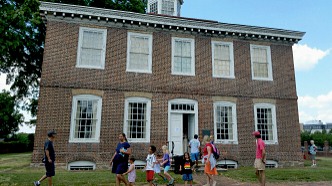Topic: COMMUNITY INTEREST


Today, marked the third annual old-fashion ice cream social at the William Trent house in Trenton, NJ. The residents who attended were served free ice cream sundaes (donated by Arctic ice cream), tourse of Trent house, music and discussions with the master gardeners.
Upon entering Trent House we were greeted by the ever gracious, Shawn Carey, a docent at Trent house. She has served as a tour guide/docent since 2014. She gave us a wondersul overivew of the home and its inventory.
William Trent built his country estate north of Philadelphia, in New Jersey, at the Falls of the Delaware River about 1719. It was a large, imposing brick structure, built in the newest fashion. An “allee” of English cherry trees led from the entrance down to the ferry landing. Nearby, there were numerous outbuildings as well as grist, saw and fulling mills along the Assunpink Creek. In 1720 Trent laid out a settlement, which he incorporated and named “Trenton.”
A number of different people have resided in the Trent House during its long history. After Trent died, his son James sold “300 acres plus the brick dwelling house” to William Morris of Barbados who was the half-brother of his father’s second wife, Mary Coddington Trent.
1742 the house was leased to the first Governor of New Jersey, Lewis Morris. Gov. Morris used the house, then called “Bloomsbury Court,” as his official residence until 1746, despite the fact that it was then owned by the Governor of Pennsylvania, George Thomas.
During the American Revolution, the Trent House was occupied by Hessian forces and played a prominent role in several battles fought at Trenton during December of 1776. Later, Dr. William Bryant, the owner of the property, was expelled for his Tory sympathies. Colonel John Cox, a wealthy Philadelphia patriot and Deputy Quartermaster General of the Continental Army, acquired the house and turned the grounds into a supply depot for Washington’s army.
The house returned to prominence in 1835 when Philemon Dickerson, a well-known Jacksonian Democrat, purchased it. The following year he was elected Governor and used the Trent House as his Official Residence.
Again in 1854 it served as the Official Residence of the Governor when the property was purchased by Governor Rodman McCamley Price. Price, a Democrat, made his fortune in the San Francisco Gold Rush of 1849, returning to New Jersey to enter politics.
The last private owner of the Trent House, Edward A. Stokes, donated the building to the City of Trenton in 1929 with the condition that it be returned to its appearance during the William Trent era and be used as a library, art gallery or museum.
After extensive restoration, the Trent House opened as a museum in 1939. Today it is owned by the City of Trenton and operated by the Trent House Association. The William Trent House is a designated National Historic Landmark and is listed in both the State and National Registers of Historic Places.
We then ventured outside and had a conversation with the master gardeners on hand. We learned that Mr Trent had an extensive historic kitchen garden at the William Trent House is designed and managed by Historic Horticulturist Charlie Thomforde, with the assistance of numerous dedicated volunteers from the Rutgers Master Gardeners of Mercer County. When William Trent built his home in what would become the City of Trenton there were no grocery stores or produce markets. Families needed to be relatively self-sufficient. A kitchen garden served to provide food and medicines. Vegetables, herbs, flowers and fruits were grown side by side and used for food, drink, cosmetics, medicine, and more.
Though considerably smaller then Trent’s own garden would have been today’s garden is planted in an 18th century style with raised beds and tamped dirt paths between and within the beds. Just as the Trent House is symmetrical, so is the garden. It is divided into four equal squares, as was the custom of the day. All the plants grown in the garden are heirloom varieties, similar to those that would have been grown in the Trents’ garden.
This link will take you to photos from today's event
https://www.facebook.com/Duffyculturalcourture/?fref=ts#
While the name of many of these 18th century plants are often familiar, the appearance frequently is not. Some of the plants are not as big or colorful: Carrots are short and stubby. Cardoons, a member of the artichoke family, have a strong bitter flavor while citron melons have little taste at all.
A close view of the heirloom garden during the summer when vegetables are almost ready for harvest, showing the beautiful variety of greens and a row of lavender flowers paralleling the red brick rear perimeter wall.The kitchen garden is a year-round activity. Peas, cabbages, lettuces, spinach, turnips, and radishes are planted during the cool spring weather.
The warm days of summer find melons, beans, cucumbers and carrots growing while the cool days of fall require planting “cover” crops, such as winter rye. In the spring these crops are not harvested but are turned into the soil to add nutrients. Some crops, like cabbages and peas are planted in the fall and allowed to “winter-over,” ready for harvest in the spring. The fava beans and peas that we got to sample were fantastic!
Children and adult groups come to the Trent House Museum throughout the year to learn about early 18th century gardening methods, plants, and plant uses.
The William Trent House is located on the corner of William Trent Place and Market Street, across from the Hughes Justice Complex. (15 Market Street in Trenton, NJ)
Hours
Wednesdays – Sundays: 12:30 to 4:00. Closed municipal holidays.
Admission
Adults $5.00
Seniors $4.00
Children $4.00
